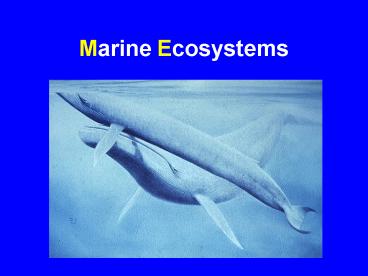Marine Ecosystems PowerPoint PPT Presentation
1 / 30
Title: Marine Ecosystems
1
Marine Ecosystems
2
Marine Wildlife Habitat(birds, mammals, reptiles)
- aquatic feeding environment
- breeding environment (can be terrestrial)
3
Marine Wildlife Habitat
- neritic watersthese are waters that lie over the
continental shelf the outer limit of the neritic
waters roughly corresponds with the 200 meter
depth contour. This tends to be the richest area
for feeding.
4
Marine Wildlife Habitat
- oceanic watersthese are deep waters that are
seaward of the continental shelf break.
5
Ocean currents and wind patterns
6
upwellings
upwellings
Ocean currents and wind patterns
7
Marine Wildlife Habitat
- Marine wildlife distribution
- reflects feeding areas, can be further refined
into the inshore (I), offshore (O), and pelagic
(P) zones
Zones
I
O
P
Continental shelf
Continental land mass
8
Marine Wildlife Habitat
- Marine wildlife distribution
Inshore zone (I)- from high water mark to about
4-5 miles out to sea.
Zones
I
O
P
Continental shelf
Continental land mass
9
Marine Wildlife Habitat
- Marine wildlife distribution
Offshore zone (O)- the region from the outer
edge of the inshore zone to the continental
shelf edge.
Zones
I
O
P
Continental shelf
Continental land mass
10
Marine Wildlife Habitat
- Marine wildlife distribution
Pelagic zone (P)- comprises the entire deep ocean
outside the shelf areas (oceanic waters).
Zones
I
O
P
Continental shelf
Continental land mass
11
Breeding Habitat
- Marine birds often nest in colonies on islands,
cliffs
Laysan albatross, Midway Island
12
(No Transcript)
13
Breeding Habitat
- Sea turtles return to natal beach to lay eggs in
sand, either alone or in arribadas
Olive ridley turtles in Costa Rica
14
Breeding Habitat
- Whales may migrate from feeding to breeding
grounds every year
Grey whale migration route
15
Aquatic and Marine Adaptations
- Mammals
- 1. Structural adaptations
- a. fusiform body shape
- b. thick blubber layer
- c. flippers, fins, or webbed feet
- d. some with valves in nose
16
Aquatic and marine adaptations
- 2. Physiological adaptations
- a. active in apnea (high O2 concentration in
blood) - b. rapid gas exchange
- c. red blood cells, myoglobin
- d. drop in heart rate during dives
17
Aquatic and marine adaptations
- Birds
- 1. Structural adaptations
- a. fusiform body shape
- b. thick fat layer
- c. dense feathers
- d. webbed feet
- e. protective eyelids
Note shape
18
Aquatic and marine adaptations
- 2. Physiological adaptations
- a. air sac system
- b. rapid gas exchange
- c. red blood cells, myoglobin
- d. drop in heart rate during dives
19
The Bering Sea Ecosystem
20
Bering Sea Ecosystem
- One of worlds richest marine areas
- Large numbers of seabirds and marine mammals
(whales, pinnipeds,walrus) - One of worlds largest fisheries-walleye pollock
(a bottom fish) - Not harvested until about 1970
21
Bering Sea Ecosystem
- Used for imitation crab other products
- Early 1990s-catch plummeted
- Large by-catch of other fish were correlated with
declines in some marine mammals and birds - Major species impacted-Stellers sea lion and
Alaska fur seal.
22
Bering Sea Ecosystem
- Stellers sea lion population has crashed
- Poor pup survival
- No evidence of unusual pathogens
- No problems with toxic chemicals
- Pups die of starvation
- Points to food chain problems
- Overfishing??
23
Bering Sea Ecosystem
- Commercial harvest of fur seals limited since
1911 - Alaska fur seal population declined by half
during 70s - Harvest ceased in 1983 after declines
- Parental feeding normal, animals healthy
- Possible net mortality of 30,000/year
24
Drift Gill-net fisheries
- Gill-net fishery important in various parts of N.
America and other parts of the world. - Major problem is incidental take
- Seabirds, sea turtles, dolphins
- 100,000s of animals killed each year world-wide
25
Green Sea Turtle
26
(No Transcript)
27
(No Transcript)
28
Estuary Ecosystems
- Partially sheltered areas where rivers discharge
into ocean - Fresh to saltwater salinity gradient
- Highly productive ecosystems
- Salt marsh in temperate zone, mangroves in tropics
29
Salt marsh
Spartina patens
Spartina alterniflora
30
Mangrove estuary

